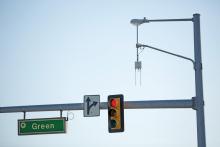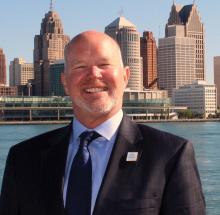The world of intelligent transport systems can, it would seem, be just as beset by muddled thinking as any other sector. How else to interpret the baffling announcement in January by the US Federal Communications Commission (FCC) chairman Julius Genachowski that the FCC intends to open up almost 200MHz of spectrum in the 5GHz band to unlicensed users, starting almost immediately? As the FCC itself points out, this would be the largest block of unlicensed spectrum to be made available for Wi-Fi in nearly te

The world of intelligent transport systems can, it would seem, be just as beset by muddled thinking as any other sector. How else to interpret the baffling
announcement in January by the US2115 Federal Communications Commission (FCC) chairman Julius Genachowski that the FCC intends to open up almost 200MHz of spectrum in the 5GHz band to unlicensed users, starting almost immediately?
As the FCC itself points out, this would be the largest block of unlicensed spectrum to be made available for Wi-Fi in nearly ten years. But while it might well bring welcome relief to congested Wi-Fi networks around the US, and while it might also, in Genachowski’s words, help develop “a next generation of spectrum policies to drive our mobile future”, it leaves DSRC services in the 5.9GHz band in something of a dead end.
Since the 5.9GHz band has been dedicated up to now for ITS safety applications based on DSRC, those involved with the US Connected Vehicle Research Program have, naturally, reacted with considerable anxiety to the news. Little wonder, perhaps, that the FCC announcement was swiftly followed by the dispatch of a letter from a group of ITS professionals led by the Intelligent Transportation Society of America to the National Telecommunications & Information Administration (NTIA), calling for a chance to participate more fully in the decision-making process.
The 5.9GHz band has been allocated for ITS safety applications based on DSRC since 1999 and has long been accepted as the foundation and future for connected vehicle technologies. Those technologies, suggests the324 US Department of Transportation (USDOT), could help avoid 80% of unimpaired crashes through applications like lane departure and forward collision warnings, intersection collision avoidance systems and approaching emergency vehicle alerts, to name just a few.
Opening up this spectrum to other services and devices may well be necessary in the greater scheme of things, perhaps – but as a recent report from the NTIA itself points out, there are risks associated with introducing a substantial number of new, unlicensed devices into the 5.9GHz band without proper safeguards and more needs to be done to determine whether and how those risks can be mitigated.
The emerging connected vehicle industry has invested hundreds of millions of dollars as well as thousands of manhours in the last decade or so on research and development under the USDOT’s Connected Vehicle Research Program. As560 ITS America has now made very clear, efforts to open up more spectrum for Wi-Fi could potentially undermine that entire connected vehicle program.
Of course it’s not just in the US that policymakers sometimes find themselves at odds with the use of intelligence in the field of transportation. In Europe, for example, there are now growing opportunities to combine different forms of technology – at sensor, roadside infrastructure and application level – into fewer ‘boxes’ and many benefits to be gained by so doing. Linking enforcement cameras with traffic monitoring systems, for instance, or automatic number plate recognition with access control are just two examples.
Sadly, however, while convergence of different technologies and systems may seem to be a very natural step forward operationally and a positive boon to cash-strapped local authorities fiscally, it does not always suit legislators and politicians – especially where they have sought to artificially separate systems that logically work well together into different camps for the sake of public acceptance.
While the ITS sector has much to offer both road users and road authorities around the world, it can only do so if local and national policies allow it and the opportunities on offer are handled in a consistent, logical and appropriate manner.
On that score, it seems, there is still some way to go before intelligent transport systems can fulfill their true potential.
announcement in January by the US
As the FCC itself points out, this would be the largest block of unlicensed spectrum to be made available for Wi-Fi in nearly ten years. But while it might well bring welcome relief to congested Wi-Fi networks around the US, and while it might also, in Genachowski’s words, help develop “a next generation of spectrum policies to drive our mobile future”, it leaves DSRC services in the 5.9GHz band in something of a dead end.
Since the 5.9GHz band has been dedicated up to now for ITS safety applications based on DSRC, those involved with the US Connected Vehicle Research Program have, naturally, reacted with considerable anxiety to the news. Little wonder, perhaps, that the FCC announcement was swiftly followed by the dispatch of a letter from a group of ITS professionals led by the Intelligent Transportation Society of America to the National Telecommunications & Information Administration (NTIA), calling for a chance to participate more fully in the decision-making process.
The 5.9GHz band has been allocated for ITS safety applications based on DSRC since 1999 and has long been accepted as the foundation and future for connected vehicle technologies. Those technologies, suggests the
Opening up this spectrum to other services and devices may well be necessary in the greater scheme of things, perhaps – but as a recent report from the NTIA itself points out, there are risks associated with introducing a substantial number of new, unlicensed devices into the 5.9GHz band without proper safeguards and more needs to be done to determine whether and how those risks can be mitigated.
The emerging connected vehicle industry has invested hundreds of millions of dollars as well as thousands of manhours in the last decade or so on research and development under the USDOT’s Connected Vehicle Research Program. As
Of course it’s not just in the US that policymakers sometimes find themselves at odds with the use of intelligence in the field of transportation. In Europe, for example, there are now growing opportunities to combine different forms of technology – at sensor, roadside infrastructure and application level – into fewer ‘boxes’ and many benefits to be gained by so doing. Linking enforcement cameras with traffic monitoring systems, for instance, or automatic number plate recognition with access control are just two examples.
Sadly, however, while convergence of different technologies and systems may seem to be a very natural step forward operationally and a positive boon to cash-strapped local authorities fiscally, it does not always suit legislators and politicians – especially where they have sought to artificially separate systems that logically work well together into different camps for the sake of public acceptance.
While the ITS sector has much to offer both road users and road authorities around the world, it can only do so if local and national policies allow it and the opportunities on offer are handled in a consistent, logical and appropriate manner.
On that score, it seems, there is still some way to go before intelligent transport systems can fulfill their true potential.








